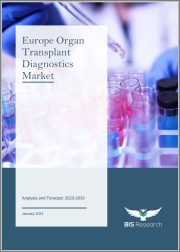
|
시장보고서
상품코드
1413712
유럽 장기 이식 진단 시장 : 분석 및 예측(2023-2033년)Europe Organ Transplant Diagnostics Market: Analysis and Forecast, 2023-2033 |
||||||
유럽 장기 이식 진단 시장 규모는 2023년 11억 6,000만 달러에서 예측 기간 동안 11.15%의 연평균 복합 성장률(CAGR)로 성장을 지속하여 2033년에는 33억 5,000만 달러의 규모에 도달할 것으로 예측되고 있습니다.
장기 부전을 일으키는 만성 질환의 급증, 이식 진단의 이용 확대, 줄기 세포 치료의 수용 확대, 이식 진단 검사 수요를 촉진하는 백혈병 환자 증가, 이식 진단 분야에 있어서의 분자·게놈 기술의 진보로부터 얻을 수 있는 이점, 상환 제도를 포함한 유리한 규제 조건의 존재를 포함하여 몇 가지 주요 요인이 시장의 성장을 뒷받침하고 있습니다.
| 주요 시장 통계 | |
|---|---|
| 예측 기간 | 2023-2033년 |
| 2023년 평가 | 11억 6,000만 달러 |
| 2033년 예측 | 33억 5,000만 달러 |
| CAGR | 11.15% |
이 보고서는 유럽의 장기 이식 진단 시장을 조사했으며, 시장 개요, 시장 성장에 대한 각종 영향요인 분석, 시장 규모 추이 및 예측, 주요 국가별 상세 분석, 주요 기업 분석 등을 정리했습니다.
시장 분류
세분화 1: 국가별
- 독일
- 영국
- 프랑스
- 이탈리아
- 스페인
- 스위스
- 기타
주요 기업:
|
|
목차
주요 요약
제1장 제품 정의
제2장 시장의 범위
제3장 조사 방법
제4장 개요
- 현재의 시장 시나리오
- 연구기관 용도
- 진단 용도
- 시장 실적
- COVID-19에 의한 시장에 대한 영향
제5장 유럽
- 유럽
- 유럽의 장기 이식 검사 건수 : 이식 유형별
- 시장 규모와 예측
제6장 기업 프로파일
- 제조업자
“The Europe Organ Transplant Diagnostics Market Expected to Reach $3.35 Billion by 2033.”
Introduction to Europe Organ Transplant Diagnostics Market
In 2023, the Europe organ transplant diagnostics market was valued at $1.16 billion and is expected to reach $3.35 billion by 2033, with a CAGR of 11.15% during the forecast period 2023-2033. Several key factors are propelling growth in this sector, including a surge in the prevalence of chronic diseases resulting in organ failure, a heightened utilization of transplant diagnostics, a growing acceptance of stem cell therapy, an increase in leukemia cases driving demand for transplant diagnostic tests, the benefits derived from the advancement of molecular and genomic technologies in the field of transplant diagnostics, and the existence of favorable regulatory conditions, encompassing reimbursement schemes.
| KEY MARKET STATISTICS | |
|---|---|
| Forecast Period | 2023 - 2033 |
| 2023 Evaluation | $1.16 Billion |
| 2033 Forecast | $3.35 Billion |
| CAGR | 11.15% |
Market Introduction
The Europe organ transplant diagnostics market is experiencing significant growth driven by factors such as the increasing incidence of chronic diseases leading to organ failure. This rise in conditions like kidney, liver, and heart diseases fuels the demand for organ transplants and subsequently, transplant diagnostics. Adoption of transplant diagnostics is on the upswing due to advancements in medical technology and heightened awareness of the importance of pre-transplant compatibility testing. The growing acceptance of stem cell therapy also contributes to the demand for transplant diagnostics. Additionally, the prevalence of leukemia cases necessitates accurate diagnostic tests before bone marrow or stem cell transplantation. Advanced molecular and genomic technologies in transplant diagnostics enhance compatibility assessments. Europe's favorable regulatory environment, including reimbursement schemes, encourages investment in transplant diagnostics by healthcare providers and patients alike. These factors collectively drive growth in the Europe organ transplant diagnostics market, making it a dynamic sector for healthcare advancements.
Market Segmentation:
Segmentation 1: by Country
- Germany
- U.K.
- France
- Italy
- Spain
- Switzerland
- Rest-of-Europe
How can this report add value to an organization?
Growth/Marketing Strategy: The Europe organ transplant diagnostics market has witnessed major development by key players operating in the market, such as product launches, business expansions, partnerships, collaborations, mergers and acquisitions, funding activities, and regulatory and legal approvals. The favored strategy for the companies has been synergistic activities such as partnerships, collaborations, expansions, and funding activities.
Competitive Strategy: The key players in the Europe organ transplant diagnostics market analyzed and profiled in the study involve established and emerging players that offer different products and services for organ transplant diagnostics. Moreover, a detailed competitive benchmarking of the players operating in the Europe organ transplant diagnostics market has been done to help the reader understand the ways in which players stack against each other, presenting a clear market landscape. Moreover, comprehensive competitive strategies such as partnerships, agreements, collaborations, and mergers and acquisitions will help the reader understand the untapped revenue pockets in the market.
Key Market Players and Competition Synopsis
The companies that are profiled have been selected based on inputs gathered from primary experts and analyzing company coverage, product portfolio, and market penetration.
Some of the prominent names in this market are:
|
|
Table of Contents
Executive Summary
1. Product Definition
- 1.1. Inclusion and Exclusion Criteria
2. Market Scope
- 2.1. Key Questions Answered in the Report:
3. Research Methodology
- 3.1. Organ Transplant Diagnostics Market: Research Methodology
- 3.2. Data Sources
- 3.2.1. Primary Data Sources
- 3.2.2. Secondary Data Sources
- 3.3. Market Estimation Model
- 3.4. Criteria for Company Profiling
4. Overview
- 4.1. Current Market Scenario
- 4.1.1. For Researchers
- 4.1.2. For Diagnostics
- 4.2. Market Footprint
- 4.3. COVID-19 Impact on Market
- 4.3.1. Impact on Operations
- 4.3.2. COVID-19 Impact: Current Scenario of Market
- 4.3.3. Pre- and Post-COVID-19 Impact Assessment
- 4.3.3.1. Pre-COVID-19 Phase
- 4.3.3.2. Post-COVID-19 Phase
5. Europe
- 5.1. Europe
- 5.1.1. Europe Organ Transplant Test Volume, by Transplant Type
- 5.1.2. Market Sizing and Forecast
- 5.1.2.1. Europe Organ Transplant Diagnostics Market (by Country)
- 5.1.2.1.1. France
- 5.1.2.1.2. Spain
- 5.1.2.1.3. U.K.
- 5.1.2.1.4. Italy
- 5.1.2.1.5. Germany
- 5.1.2.1.6. Switzerland
- 5.1.2.1.7. Rest-of-Europe
- 5.1.2.1. Europe Organ Transplant Diagnostics Market (by Country)
6. Company Profiles
- 6.1. Overview
- 6.2. Manufacturers
- 6.2.1. BAG Group GmbH
- 6.2.1.1. Company Overview
- 6.2.1.2. Role of BAG Group GmbH in the Organ Transplant Diagnostics Market
- 6.2.1.3. Product Portfolio
- 6.2.1.4. Analyst Perception
- 6.2.2. bioMerieux S.A.
- 6.2.2.1. Company Overview
- 6.2.2.2. Role of bioMerieux S.A. in the Organ Transplant Diagnostics Market
- 6.2.2.3. Product Portfolio
- 6.2.2.4. Financials
- 6.2.2.5. Recent Developments
- 6.2.2.6. Analyst Perception
- 6.2.3. Eurobio Scientific (Genome Diagnostics B.V.)
- 6.2.3.1. Company Overview
- 6.2.3.2. Role of Eurobio Scientific (Genome Diagnostics B.V.) in the Organ Transplant Diagnostics Market
- 6.2.3.3. Product Portfolio
- 6.2.3.4. Analyst Perception
- 6.2.4. F. Hoffmann-La Roche Ltd.
- 6.2.4.1. Company Overview
- 6.2.4.2. Role of F. Hoffmann-La Roche Ltd. in the Organ Transplant Diagnostics Market
- 6.2.4.3. Product Portfolio
- 6.2.4.4. Financials
- 6.2.4.5. Recent Developments
- 6.2.4.6. Analyst Perception
- 6.2.5. Omixon Inc.
- 6.2.5.1. Company Overview
- 6.2.5.2. Role of Omixon Inc. in the Organ Transplant Diagnostics Market
- 6.2.5.3. Product Portfolio
- 6.2.5.4. Analyst Perception
- 6.2.6. QIAGEN N.V.
- 6.2.6.1. Company Overview
- 6.2.6.2. Role of QIAGEN N.V. in the Organ Transplant Diagnostics Market
- 6.2.6.3. Product Portfolio
- 6.2.6.4. Financials
- 6.2.6.5. Recent Developments
- 6.2.6.6. Analyst Perception
- 6.2.1. BAG Group GmbH



















